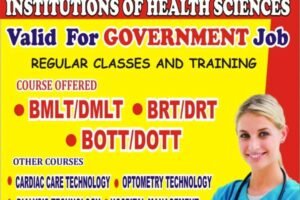From Classroom to Clinic
In the healthcare sector, practical training is a cornerstone of education. For students in nursing and paramedical courses, the transition from classroom learning to real-world clinical practice is pivotal. This hands-on experience bridges the gap between theoretical knowledge and practical application, ensuring that graduates are well-equipped to provide high-quality patient care. This article explores the impact of practical training on nursing and paramedical education, highlighting its significance, benefits, and influence on career readiness.(From Classroom to Clinic)
From Classroom to Clinic

The Role of Practical Training in Healthcare Education
1. Bridging Theory and Practice
Practical training provides students with the opportunity to apply theoretical concepts learned in the classroom to real-world scenarios. This hands-on experience is crucial for developing a deep understanding of medical procedures, patient interactions, and clinical decision-making. By working directly with patients and healthcare teams, students gain invaluable insights that enhance their overall competency and confidence.
2. Developing Clinical Skills
In nursing and paramedical courses, students are trained in a wide range of clinical skills, including patient assessment, emergency response, and medical procedures. Practical training allows students to practice these skills in a controlled environment before applying them in real-world settings. This process helps students refine their techniques, learn to manage various medical equipment, and develop the dexterity required for effective patient care.
3. Enhancing Problem-Solving Abilities
The dynamic nature of clinical settings presents students with complex and unpredictable situations. Practical training equips students with the problem-solving skills needed to handle emergencies, adapt to changing conditions, and make critical decisions. These experiences foster the ability to think on their feet and respond effectively to diverse clinical challenges.
From Classroom to Clinic
Benefits of Practical Training for Students
1. Increased Competency and Confidence
One of the most significant benefits of practical training is the enhancement of competency and confidence among students. By applying their knowledge in real-life scenarios, students become more proficient in their roles and develop a greater sense of self-assurance. This increased confidence is essential for providing effective patient care and managing clinical responsibilities.
2. Improved Communication Skills
Effective communication is a vital aspect of healthcare. Practical training provides students with opportunities to interact with patients, families, and healthcare professionals. Through these interactions, students learn to communicate clearly, provide compassionate care, and navigate complex interpersonal dynamics. Strong communication skills are crucial for building trust with patients and collaborating effectively with colleagues.
3. Exposure to Diverse Clinical Environments
Practical training exposes students to a variety of clinical environments, including hospitals, clinics, and community health settings. This exposure helps students understand different aspects of healthcare delivery and prepares them for diverse career opportunities. Experience in multiple settings also broadens their understanding of patient needs and healthcare challenges.
4. Real-World Experience
Hands-on training offers students real-world experience that goes beyond textbook learning. They encounter actual patient cases, deal with practical issues, and witness the impact of their work on patient outcomes. This experience provides a realistic perspective on the healthcare profession and prepares students for the demands of their future roles.
Impact on Career Readiness
1. Enhanced Job Readiness
Practical training significantly enhances job readiness by ensuring that students are prepared for the responsibilities and challenges of their chosen professions. Employers value graduates who have hands-on experience and can seamlessly transition from education to the workforce. Practical training equips students with the skills and knowledge needed to perform effectively in their roles.
2. Stronger Professional Relationships
Building professional relationships is a key aspect of career development in healthcare. During practical training, students have the opportunity to network with healthcare professionals, mentors, and peers. These connections can provide valuable support, guidance, and career opportunities in the future.
3. Greater Understanding of Workplace Dynamics
Experiencing real clinical environments allows students to gain a deeper understanding of workplace dynamics, including team collaboration, patient care protocols, and organizational structures. This understanding helps students adapt to the working environment and contribute effectively to healthcare teams.
4. Improved Patient Care
The ultimate goal of practical training is to improve patient care. By developing clinical skills, problem-solving abilities, and communication strategies, students are better equipped to deliver high-quality care. Practical training ensures that graduates are ready to meet the needs of patients and provide safe, effective, and compassionate care.
Examples of Practical Training in Nursing and Paramedical Courses
1. Clinical Rotations
In nursing and paramedical courses, clinical rotations are a fundamental component of practical training. Students rotate through various departments, such as emergency care, pediatrics, and internal medicine, gaining exposure to different specialties and patient populations. These rotations provide hands-on experience and allow students to apply their learning in diverse clinical settings.
2. Simulation Labs
Simulation labs offer a controlled environment where students can practice clinical skills using realistic mannequins and medical equipment. These labs simulate various scenarios, including emergency situations and routine procedures, allowing students to develop their skills and confidence before working with actual patients.
3. Fieldwork and Internships
Fieldwork and internships provide students with opportunities to work in real healthcare settings under the supervision of experienced professionals. These experiences allow students to apply their knowledge, receive feedback, and gain practical insights into the day-to-day operations of healthcare facilities.
4. Practical Assessments
Practical assessments evaluate students’ ability to perform specific clinical tasks and procedures. These assessments are conducted in clinical settings or simulation labs and provide a measure of students’ proficiency and readiness for professional practice.
From Classroom to Clinic
Impact of Paramedical Professionals on Public Health: A Closer Look
Conclusion
Practical training is a critical component of nursing and paramedical education, bridging the gap between classroom learning and real-world application. By providing hands-on experience, developing clinical skills, and enhancing problem-solving abilities, practical training prepares students for successful careers in healthcare.
The benefits of practical training extend to increased competency and confidence, improved communication skills, and exposure to diverse clinical environments. These experiences not only enhance job readiness but also contribute to better patient care and professional growth.
As students transition from the classroom to the clinic, the impact of practical training becomes evident. It equips them with the skills, knowledge, and experience needed to excel in their roles and make meaningful contributions to the healthcare field. For those pursuing careers in nursing and paramedicine, embracing practical training is essential for achieving career success and delivering high-quality patient care.

